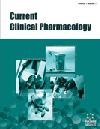- Home
- A-Z Publications
- Current Clinical Pharmacology
- Previous Issues
- Volume 5, Issue 1, 2010
Current Clinical Pharmacology - Volume 5, Issue 1, 2010
Volume 5, Issue 1, 2010
-
-
Trends in Utilization of the Pharmacological Potential of Chalcones
More LessAuthors: Daniela I. Batovska and Iva Todorova TodorovaChalcones (1,3-diaryl-2-propen-1-ones) are open chain flavonoids that are widely biosynthesized in plants. They are important for the pigmentation of flowers and, hence, act as attractants to the pollinators. As flavonoids, chalcones also play an important role in defense against pathogens and insects. A longstanding scientific research has shown that chalcones also display other interesting biological properties such as antioxida Read More
-
-
-
Hyperhomocysteinemia and Cardiovascular Risk: Effect of Vitamin Supplementation in Risk Reduction
More LessAuthors: Marcello Ciaccio and Chiara BelliaHomocysteine is a sulfur-containing aminoacid produced during metabolism of methionine. Since 1969 the relationship between altered homocysteine metabolism and both coronary and peripheral atherotrombosis has been known; in recent years experimental evidences have shown that elevated plasma levels of homocysteine are associated with an increased risk of atherosclerosis and cardiovascular ischemic event Read More
-
-
-
In Silico Drug Discovery Approaches on Grid Computing Infrastructures
More LessAuthors: Antje Wolf, Mohammad Shahid, Vinod Kasam, Wolfgang Ziegler and Martin Hofmann-ApitiusThe first step in finding a “drug” is screening chemical compound databases against a protein target. In silico approaches like virtual screening by molecular docking are well established in modern drug discovery. As molecular databases of compounds and target structures are becoming larger and more and more computational screening approaches are available, there is an increased need in compute power and more comple Read More
-
-
-
Antibiotics in Endophthalmitis: Microbiological and Pharmacokinetic Considerations
More LessAuthors: Carmen Lopez-Cabezas, Dolors S. Muner, Merce Roca Massa and Josep M. Mensa PueyoOcular infections must be treated with active antibiotics which could be administered by different routes: topical, systemic or intravitreal. In the case of endophthalmitis, the most important factor to avoid permanent damage of retina is an early antibiotic onset. Topical application of these drugs would be ineffective in the treatment of endophthalmitis, because of their poor penetration into the ocular globe. Systemic and int Read More
-
-
-
Mitochondria as a Promising Antiparasitic Target
More LessAuthors: Lianet Monzote and Lars GilleDiseases caused by parasitic infections are responsible for considerable morbidity and mortality. The progress in the development of vaccines against parasite infections tends to be slow and the epidemiological control of diseases is unsatisfactory. Currently, chemotherapy remains an essential component of clinical management and disease control programs. In the past 20 years, there was a significant increase in our Read More
-
-
-
Health Consequences of Catabolic Synthesis of Hippuric Acid in Humans
More LessHippuric acid has been a major human metabolite for years. However, there is no well-known documented health benefit associated with it except for excretion of environmental-toxic exposures of aromatic compounds such as toluene, or from dietary protein degradation and re-synthesis by intestinal microflora metabolism of quinic acid via the shikimate pathway. Thus hippuric acid can appear in humans as an excretory prod Read More
-
Volumes & issues
Most Read This Month
Article
content/journals/ccp
Journal
10
5
false
en


